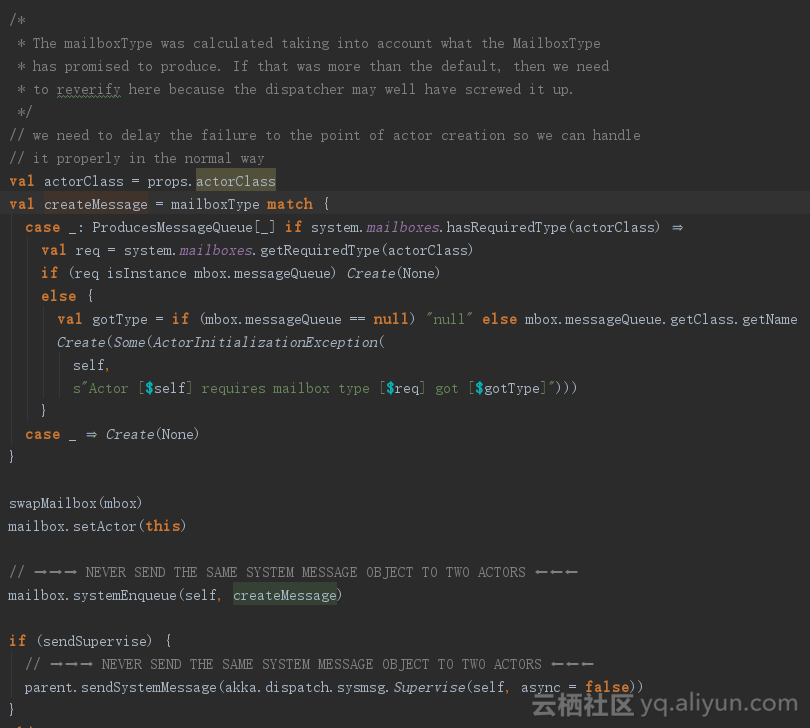Akka源码分析-Actor创建(续)
在上一遍博客中,我们已经分析了actor创建的大致过程,但只是涉及到了Dipatcher/Mailbox/ActorCell/InternalActorRef等对象的创建,并没有介绍我们自定义的继承Actor特质的类如何完成初始化。这篇文章对这一部分内容进行简单的补充。
在akka.actor.dungeon.init代码中,有一段代码我们当时没有分析,此处对此代码进行深入分析,然后才能找到Actor子类完成创建的真实过程。
上面是init的代码片段,其中有一个局部变量createMessage,根据前后分析,它的值应该是Create这个case
class。最后mailbox.systemEnqueue(self,
createMessage)这个代码给actor对应的邮箱发送了该消息。
/**
* INTERNAL API
*/
@SerialVersionUID(1L)
private[akka] final case class Create(failure: Option[ActorInitializationException]) extends SystemMessage // sent to self from Dispatcher.register根据Create类名以及前后上下文分析,这应该是指示Actor完成初始化的。那么我们要分析一下actor是如何对该消息响应的。那么究竟是哪段代码对这个消息进行响应的呢?
如果读过之前的文章,你肯定能想起来Mailbox在循环处理消息时,有一个processAllSystemMessages方法,这个方法里面调用了actor的systemInvoke方法。具体源码如下:
/**
* Will at least try to process all queued system messages: in case of
* failure simply drop and go on to the next, because there is nothing to
* restart here (failure is in ActorCell somewhere …). In case the mailbox
* becomes closed (because of processing a Terminate message), dump all
* already dequeued message to deadLetters.
*/
final def processAllSystemMessages() {
var interruption: Throwable = null
var messageList = systemDrain(SystemMessageList.LNil)
while ((messageList.nonEmpty) && !isClosed) {
val msg = messageList.head
messageList = messageList.tail
msg.unlink()
if (debug) println(actor.self + " processing system message " + msg + " with " + actor.childrenRefs)
// we know here that systemInvoke ensures that only "fatal" exceptions get rethrown
actor systemInvoke msg
if (Thread.interrupted())
interruption = new InterruptedException("Interrupted while processing system messages")
// don’t ever execute normal message when system message present!
if ((messageList.isEmpty) && !isClosed) messageList = systemDrain(SystemMessageList.LNil)
}
/*
* if we closed the mailbox, we must dump the remaining system messages
* to deadLetters (this is essential for DeathWatch)
*/
// 忽略剩余源码
}我们来研究一下systemInvoke的代码
/*
* MESSAGE PROCESSING
*/
//Memory consistency is handled by the Mailbox (reading mailbox status then processing messages, then writing mailbox status
final def systemInvoke(message: SystemMessage): Unit = {
/*
* When recreate/suspend/resume are received while restarting (i.e. between
* preRestart and postRestart, waiting for children to terminate), these
* must not be executed immediately, but instead queued and released after
* finishRecreate returns. This can only ever be triggered by
* ChildTerminated, and ChildTerminated is not one of the queued message
* types (hence the overwrite further down). Mailbox sets message.next=null
* before systemInvoke, so this will only be non-null during such a replay.
*/
def calculateState: Int =
if (waitingForChildrenOrNull ne null) SuspendedWaitForChildrenState
else if (mailbox.isSuspended) SuspendedState
else DefaultState
@tailrec def sendAllToDeadLetters(messages: EarliestFirstSystemMessageList): Unit =
if (messages.nonEmpty) {
val tail = messages.tail
val msg = messages.head
msg.unlink()
provider.deadLetters ! msg
sendAllToDeadLetters(tail)
}
def shouldStash(m: SystemMessage, state: Int): Boolean =
(state: @switch) match {
case DefaultState ⇒ false
case SuspendedState ⇒ m.isInstanceOf[StashWhenFailed]
case SuspendedWaitForChildrenState ⇒ m.isInstanceOf[StashWhenWaitingForChildren]
}
@tailrec
def invokeAll(messages: EarliestFirstSystemMessageList, currentState: Int): Unit = {
val rest = messages.tail
val message = messages.head
message.unlink()
try {
message match {
case message: SystemMessage if shouldStash(message, currentState) ⇒ stash(message)
case f: Failed ⇒ handleFailure(f)
case DeathWatchNotification(a, ec, at) ⇒ watchedActorTerminated(a, ec, at)
case Create(failure) ⇒ create(failure)
case Watch(watchee, watcher) ⇒ addWatcher(watchee, watcher)
case Unwatch(watchee, watcher) ⇒ remWatcher(watchee, watcher)
case Recreate(cause) ⇒ faultRecreate(cause)
case Suspend() ⇒ faultSuspend()
case Resume(inRespToFailure) ⇒ faultResume(inRespToFailure)
case Terminate() ⇒ terminate()
case Supervise(child, async) ⇒ supervise(child, async)
case NoMessage ⇒ // only here to suppress warning
}
} catch handleNonFatalOrInterruptedException { e ⇒
handleInvokeFailure(Nil, e)
}
val newState = calculateState
// As each state accepts a strict subset of another state, it is enough to unstash if we "walk up" the state
// chain
val todo = if (newState < currentState) unstashAll() reverse_::: rest else rest
if (isTerminated) sendAllToDeadLetters(todo)
else if (todo.nonEmpty) invokeAll(todo, newState)
}
invokeAll(new EarliestFirstSystemMessageList(message), calculateState)
}由于我们只是准备分析actor的创建过程,所以上面的代码,我们只关注对Create消息的处理:create(failure)。也就是说调用了create函数。
protected def create(failure: Option[ActorInitializationException]): Unit = {
def clearOutActorIfNonNull(): Unit = {
if (actor != null) {
clearActorFields(actor, recreate = false)
actor = null // ensure that we know that we failed during creation
}
}
failure.foreach { throw _ }
try {
val created = newActor()
actor = created
created.aroundPreStart()
checkReceiveTimeout
if (system.settings.DebugLifecycle) publish(Debug(self.path.toString, clazz(created), "started (" + created + ")"))
} catch {
case e: InterruptedException ⇒
clearOutActorIfNonNull()
Thread.currentThread().interrupt()
throw ActorInitializationException(self, "interruption during creation", e)
case NonFatal(e) ⇒
clearOutActorIfNonNull()
e match {
case i: InstantiationException ⇒ throw ActorInitializationException(
self,
"""exception during creation, this problem is likely to occur because the class of the Actor you tried to create is either,
a non-static inner class (in which case make it a static inner class or use Props(new ...) or Props( new Creator ... )
or is missing an appropriate, reachable no-args constructor.
""", i.getCause)
case x ⇒ throw ActorInitializationException(self, "exception during creation", x)
}
}
}我们来分析一下这个create函数。其中主要的逻辑都在try中,首先调用newActor函数,创建了Actor实例,然后赋值给actor字段。actor字段我们已经知道,这是ActorCell的最终actor实例。
/*
* ACTOR INSTANCE HANDLING
*/
//This method is in charge of setting up the contextStack and create a new instance of the Actor
protected def newActor(): Actor = {
contextStack.set(this :: contextStack.get)
try {
behaviorStack = emptyBehaviorStack
val instance = props.newActor()
if (instance eq null)
throw ActorInitializationException(self, "Actor instance passed to actorOf can't be 'null'")
// If no becomes were issued, the actors behavior is its receive method
behaviorStack = if (behaviorStack.isEmpty) instance.receive :: behaviorStack else behaviorStack
instance
} finally {
val stackAfter = contextStack.get
if (stackAfter.nonEmpty)
contextStack.set(if (stackAfter.head eq null) stackAfter.tail.tail else stackAfter.tail) // pop null marker plus our context
}
}newActor函数源码如上,抛去其他代码,该函数调用了props.newActor创建了最终的Actor实例,也就是我们自定义的Actor子类。通过源码注释我们知道behaviorStack是actor当前行为的一个栈。如果读者用过become的话,对这段代码应该比较好理解。我们在actor内部使用become方法改变当前actor实例的时候,其实是把新的receive函数压入栈顶,mailbox在调用receive时,其实是取出当前栈顶的receive函数进行处理的。当然这是akka以前版本的默认行为。为什么这样说呢?因为新版本默认行为就是简单的把最新的receive函数替换旧receive函数,如果想恢复旧receive函数,需要开发者在编码时,再次调用become用旧receive函数替换当前receive。为什么要这么做?当然是为了防止开发者恶意或者无意中胡乱调用become,造成栈溢出喽。
props.newActor我们不再深入分析,这应该就是通过反射创建Actor特质的子类,也就是我们自定义的actor。
至此,我们自定义的actor就真正完成了初始化。细心的读者一定会发现,就连actor最终的实例化,都是异步的。因为newActor是通过Create消息触发的,而Mailbox对所有消息的处理都是在单独的线程处理的。如果actor的创建过程中有一些线程不安全的代码,就需要注意喽。
Akka源码分析-Actor创建(续)的更多相关文章
- Akka源码分析-Actor创建
上一篇博客我们介绍了ActorSystem的创建过程,下面我们就研究一下actor的创建过程. val system = ActorSystem("firstActorSystem" ...
- Akka源码分析-Actor发消息(续)
上一篇博客我们分析道mailbox同时也是一个forkjointask,run方法中,调用了processMailbox处理一定数量的消息,然后最终调用dispatcher的registerForEx ...
- Akka源码分析-Actor&ActorContext&ActorRef&ActorCell
分析源码的过程中我们发现,Akka出现了Actor.ActorRef.ActorCell.ActorContext等几个相似的概念,它们之间究竟有什么区别和联系呢? /** * Actor base ...
- Akka源码分析-Actor发消息
前面两篇文章简单介绍了ActorSystem.actor以及dispatcher和mailbox的创建,下面我们就来看一下actor发消息的内部机制. val system = ActorSystem ...
- Akka源码分析-Remote-Actor创建
在之前的博客中,我们分析过local模式下Actor的创建过程,最终还是调用了provider的actorOf的函数创建了Actor,在remote模式下provider就是RemoteActorRe ...
- Akka源码分析-Akka-Streams-概念入门
今天我们来讲解akka-streams,这应该算akka框架下实现的一个很高级的工具.之前在学习akka streams的时候,我是觉得云里雾里的,感觉非常复杂,而且又难学,不过随着对akka源码的深 ...
- Akka源码分析-Cluster-Metrics
一个应用软件维护的后期一定是要做监控,akka也不例外,它提供了集群模式下的度量扩展插件. 其实如果读者读过前面的系列文章的话,应该是能够自己写一个这样的监控工具的.简单来说就是创建一个actor,它 ...
- Akka源码分析-Cluster-Distributed Publish Subscribe in Cluster
在ClusterClient源码分析中,我们知道,他是依托于“Distributed Publish Subscribe in Cluster”来实现消息的转发的,那本文就来分析一下Pub/Sub是如 ...
- Akka源码分析-Cluster-Singleton
akka Cluster基本实现原理已经分析过,其实它就是在remote基础上添加了gossip协议,同步各个节点信息,使集群内各节点能够识别.在Cluster中可能会有一个特殊的节点,叫做单例节点. ...
随机推荐
- uWSGI+nginx+django+virtualenv+supervisor部署项目
一.前言 在部署项目前,你已有一个能够在你本机测试过,能正常启动的Django项目(毕竟本文主要讲解部署Django项目),以及掌握了Linux系统的一些基本命令. 相关链接: Centos7安装py ...
- PYGAME学习笔记_01
01_使用PYGAME创建图形窗口 1.1_游戏的初始化和退出 pygame.init() 写入并初始化所有PYGAME模块,使用其他模块之前,必须先调用init方法 pygame.quit() 卸载 ...
- 为什么要有uboot?带你全面分析嵌入式linux系统启动过程中uboot的作用
1.为什么要有uboot 1.1.计算机系统的主要部件 (1)计算机系统就是以CPU为核心来运行的系统.典型的计算机系统有:PC机(台式机+笔记本).嵌入式设备(手机.平板电脑.游戏机).单片机(家用 ...
- 多校1010 Taotao Picks Apples
>>点击进入原题<< 思路:题解很有意思,适合线段树进阶 #include<cstdio> #include<cmath> #include<cs ...
- JavaScript及Java对JSON的相关处理
JavaScript中JSON字符串与JSON对象的互转及JSON对象的取值: var jsonString = '{"key1":"value1"," ...
- gdb个人使用记录
参考博客:https://blog.csdn.net/zdy0_2004/article/details/80102076 安装gdb,查看版本确认成功: sudo apt install gdb g ...
- 实验吧-catalyst-system
刚学逆向很多都不懂,本题也是在看了 http://countersite.org/articles/reverse_engineering/136-revers-s-alexctf-2017.html ...
- java 源码分析1 -String
1. String的本质是一个 char数组,实现了CharSequence 接口, /** The value is used for character storage. */ private f ...
- 学一学书里的django是怎么写views.py的
他山之石,可以攻玉嘛. 好的习惯有时也是学别人来养成的. 外国人的编码习惯,学啊. from django.core.urlresolvers import reverse_lazy from dja ...
- [bzoj 2705][SDOI2012]Longge的问题(数学)
题目:http://www.lydsy.com:808/JudgeOnline/problem.php?id=2705 分析: 设k为n的因数 设f[k]为gcd(x,n)==k的x的个数,容易知道a ...
